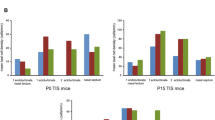Abstract
Neurospheres are potentially good tools to study olfactory neurogenesis. For this purpose, it is necessary to characterize neurospheres derived from the olfactory system. This study is aimed at identifying the regional difference of cellular composition within neurospheres derived from the adult mouse olfactory bulb, and studying whether these characteristics are maintained throughout the long-term culture. Neural cells were obtained from the olfactory bulbs of 8-week-old Balb/c mice and the dissociated cells were cultured in serum-free media containing epidermal growth factor and basic fibroblast growth factor to form neurospheres. These neurospheres were subjected to characterization by confocal microscopy after immunofluorescence staining with nestin, proliferating cell nuclear antigen (PCNA), neuronal cell adhesion molecule (NCAM), glial fibrillary acidic protein (GFAP), O4, and olfactory marker protein (OMP). Confocal microscopy showed that nestin-reactive cells, which are stem cell-like cells, were present at the periphery of neurospheres and PCNA-reactive cells undergoing proliferation were found throughout the neurospheres. Neuronal cell markers, NCAM-reactive cells, were observed at the center of neurospheres while glial cell markers, GFAP- or O4-reactive cells, were present at the periphery of neurospheres. No cells were found to be reactive for OMP, a differentiated olfactory neuron marker. This regional distribution of cells in neurospheres was maintained through 17 passages for a year. The neural lineage of cells showed different distribution within neurospheres and this localization was preserved throughout the culture period. These findings in the neurosphere culture system of the olfactory bulb may help to study olfactory neurogenesis.


Similar content being viewed by others
References
Cau E, Gradwohl G, Fode C, Guillemot F (1997) Mash1 activates a cascade of bHLH regulators in olfactory neuron progenitors. Development 124:1611–1621
Zhang X, Klueber KM, Guo Z, Cai J, Lu C, Winstead WI, Qiu M, Roisen FJ (2006) Induction of neuronal differentiation of adult human olfactory neuroepithelial-derived progenitors. Brain Res 1073–1074:109–119
Roisen FJ, Klueber KM, Lu CL, Hatcher LM, Dozier A, Shields CB, Maguire S (2001) Adult human olfactory stem cells. Brain Res 890:11–22
Schwob JE (2002) Neural regeneration and the peripheral olfactory system. Anat Rec B New Anat 269:33–49
Beites CL, Kawauchi S, Crocker CE, Calof AL (2005) Identification and molecular regulation of neural stem cells in the olfactory epithelium. Exp Cell Res 306:309–316
Kawauchi S, Beites CL, Crocker CE, Wu HH, Bonnin A, Murray R, Calof AL (2004) Molecular signals regulating proliferation of stem and progenitor cells in mouse olfactory epithelium. Dev Neurosci 26:166–180
Liu Z, Martin LJ (2003) Olfactory bulb core is a rich source of neural progenitor and stem cells in adult rodent and human. J Comp Neurol 459:368–391
Gritti A, Bonfanti L, Doetsch F, Caille I, Alvarez-Buylla A, Lim DA, Galli R, Verdugo JM, Herrera DG, Vescovi AL (2002) Multipotent neural stem cells reside into the rostral extension and olfactory bulb of adult rodents. J Neurosci 22:437–445
Parmar M, Sjoberg A, Bjorklund A, Kokaia Z (2003) Phenotypic and molecular identity of cells in the adult subventricular zone: in vivo and after expansion in vitro. Mol Cell Neurosci 24:741–752
Curtis MA, Kam M, Nannmark U, Anderson MF, Axell MZ, Wikkelso C, Holtas S, van Roon-Mom WM, Bjork-Eriksson T, Nordborg C, Frisen J, Dragunow M, Faull RL, Eriksson PS (2007) Human neuroblasts migrate to the olfactory bulb via a lateral ventricular extension. Science 315:1243–1249
Yamaguchi M, Saito H, Suzuki M, Mori K (2000) Visualization of neurogenesis in the central nervous system using nestin promoter-GFP transgenic mice. Neuroreport 11:1991–1996
Chen X, Fang H, Schwob JE (2004) Multipotency of purified, transplanted globose basal cells into olfactory epithelium. J Comp Neurol 469:457–474
Rietze RL, Valcanis H, Brooker GF, Thomas T, Voss AK, Bartlett PF (2001) Purification of a pluripotent neural stem cell from the adult mouse brain. Nature 412:736–739
Duncan HJ, Seiden AM (1995) Long-term follow-up of olfactory loss secondary to head trauma and upper respiratory tract infection. Arch Otolaryngol Head Neck Surg 121:1183–1187
Delank KW, Stoll W (1998) Olfactory function after functional endoscopic sinus surgery for chronic sinusitis. Rhinology 36:15–19
Klimek L, Moll B, Amedee RG, Mann WJ (1997) Olfactory function after microscopic endonasal surgery in patients with nasal polyps. Am J Rhinol 11:251–255
Gritti A, Parati EA, Cova L, Frolichsthal P, Galli R, Wanke E, Faravelli L, Morassutti DJ, Roisen F, Nickel DD, Vescovi AL (1996) Mulipotential stem cells from the adult mouse brain proliferate and self-renew in response to basic fibroblast growth factor. J Neurosci 16:1091–1100
Deacon TW, Pakzaban P, Isacson O (1994) The lateral ganglionic eminence is the origin of cells committed to striatal phenotypes: neural transplantation and developmental evidence. Brain Res 668:211–219
Jensen JB, Parmar M (2006) Strengths and limitations of the neurosphere culture system. Mol Neurobiol 34:153–161
Piao J, Odeberg J, Samuelsson E, Kjaeldgaard A, Falci S, Seiger A, Sundstrom E, Akesson E (2006) Cellular composition of long-term human spinal cord- and forbrain-derived neurosphere cultures. J Neurosci Res 84:471–482
Burgers PM (1988) Mammalian cyclin/PCNA (DNA polymerase delta auxiliary protein) stimulates processive DNA synthesis by yeast. Nucleic Acids Res 16:6297–6307
Acknowledgments
This study was partly supported by the ERC program of MOST/KOSEF (R11-2000-075-01004-0).
Author information
Authors and Affiliations
Corresponding author
Rights and permissions
About this article
Cite this article
Ahn, J.M., Lee, C.H., Kim, DY. et al. Maintenance of regional difference in cellular composition of neurospheres derived from adult mouse olfactory bulb. Eur Arch Otorhinolaryngol 265, 429–434 (2008). https://doi.org/10.1007/s00405-007-0487-6
Received:
Accepted:
Published:
Issue Date:
DOI: https://doi.org/10.1007/s00405-007-0487-6




